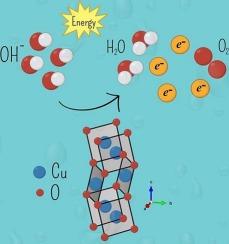通过定制氧化铜/泡沫镍界面增强析氧反应
IF 4.6
3区 材料科学
Q2 MATERIALS SCIENCE, MULTIDISCIPLINARY
引用次数: 0
摘要
采用溶胶-凝胶和低温水热相结合的方法在泡沫镍(NF)上直接生长CuO。XRD, FESEM, FT-IR和XPS分析证实了CuO晶体的形成,具有明确的形态,结构完整性和Cu2+离子的存在。在1 M KOH条件下的电化学测试表明,与常规沉积的CuO (CuO- d)相比,直接生长的CuO (CuO- g)具有更大的电化学活性面积、更低的电荷转移电阻和更高的析氧反应(OER)活性。CuO-G还表现出更低的过电位、更小的Tafel斜率和更高的周转频率(TOF),表明催化效率提高。长期试验证实了电极的结构和形态稳定性。这些结果表明,直接生长策略显著提高了CuO的电化学性能,使其成为一种有前景的能量转换和存储应用方法。本文章由计算机程序翻译,如有差异,请以英文原文为准。

Enhancing oxygen evolution reaction through tailored copper oxide/nickel foam interfaces
This study reports the synthesis of CuO directly grown on nickel foam (NF) via a combined sol-gel and low-temperature hydrothermal method. XRD, FESEM, FT-IR, and XPS analyses confirm the formation of crystalline CuO with well-defined morphology, structural integrity, and the presence of Cu2+ ions. Electrochemical tests in 1 M KOH show that the directly grown CuO (CuO-G) exhibits a larger electrochemically active area, lower charge transfer resistance, and improved oxygen evolution reaction (OER) activity compared to conventionally deposited CuO (CuO-D). CuO-G also shows lower overpotential, a smaller Tafel slope, and a higher turnover frequency (TOF), indicating enhanced catalytic efficiency. Long-term tests confirm the structural and morphological stability of the electrode. These results demonstrate that the direct growth strategy significantly enhances the electrochemical performance of CuO, making it a promising approach for energy conversion and storage applications.
求助全文
通过发布文献求助,成功后即可免费获取论文全文。
去求助
来源期刊

Materials Science and Engineering: B
工程技术-材料科学:综合
CiteScore
5.60
自引率
2.80%
发文量
481
审稿时长
3.5 months
期刊介绍:
The journal provides an international medium for the publication of theoretical and experimental studies and reviews related to the electronic, electrochemical, ionic, magnetic, optical, and biosensing properties of solid state materials in bulk, thin film and particulate forms. Papers dealing with synthesis, processing, characterization, structure, physical properties and computational aspects of nano-crystalline, crystalline, amorphous and glassy forms of ceramics, semiconductors, layered insertion compounds, low-dimensional compounds and systems, fast-ion conductors, polymers and dielectrics are viewed as suitable for publication. Articles focused on nano-structured aspects of these advanced solid-state materials will also be considered suitable.
 求助内容:
求助内容: 应助结果提醒方式:
应助结果提醒方式:


